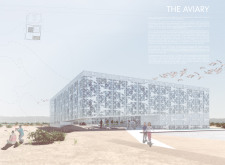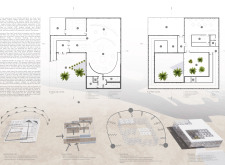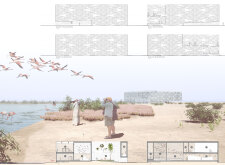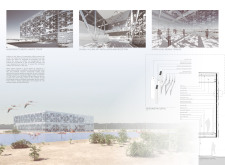5 key facts about this project
The Aviary project is an architectural endeavor situated within the Al Wathba Wetland Reserve, designed to serve as a multifunctional facility that enhances visitor engagement with the surrounding ecosystem. This project emphasizes a commitment to environmental education and conservation, making it a vital component of the region's ecological discourse.
The primary function of The Aviary is to provide an observational and educational platform for visitors interested in the region's avian life. The design incorporates various elements that promote awareness of wetland ecology, allowing for direct interaction with the natural environment. The building is strategically positioned to maximize views of the wetlands, offering spaces for observation, learning, and community gatherings.
Architectural Elements and Details
The architectural design features a cubic form defined by a lattice façade that simulates the texture and patterns found in feathers. This approach not only enhances aesthetic appeal but also improves building performance through effective solar control and natural ventilation. Extensive use of glass creates visibility between the interior and exterior, reinforcing the connection between the built environment and the natural landscape.
Highlighting the project’s commitment to sustainability, materials include high-performance glazing to optimize natural lighting while minimizing energy use. Aluminum louvers provide passive shading, reducing thermal gain while maintaining visibility. Composite wood panels add a tactile quality to the design, integrating warmth into the structure's visual language. The foundation is reinforced with concrete to ensure durability within the wetland context.
Unique Design Approaches
A defining feature of The Aviary is its emphasis on biophilic design principles, which promote a direct connection to nature. Internal courtyards and viewing areas are purposefully designed to allow visitors to engage with wildlife without intrusion. This strategy not only enhances the visitor experience but also contributes to the overall mission of conservation and education.
Another unique aspect is the experiential circulation path that guides visitors through different viewing opportunities. This deliberate design choice encourages exploration and fosters a sense of connection to the local environment. Educational spaces within the facility are equipped for workshops and public programs, establishing The Aviary as a center for community engagement and ecological learning.
The project integrates sustainable practices, including rainwater harvesting systems that utilize natural resources efficiently and sensibly. These features exemplify a modern architectural approach that balances functionality with environmental mindfulness.
For those interested in the detailed architectural plans, sections, and overall design considerations, exploring the full presentation of The Aviary can provide comprehensive insights into the project's architecture and its unique contribution to the interaction between built and natural environments.






















































